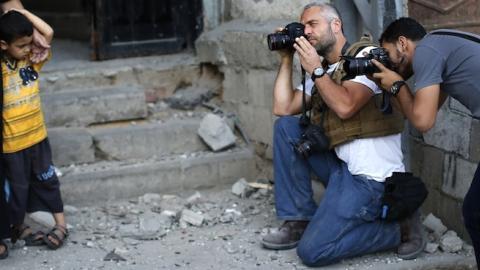During the six weeks of Israel’s Operation Protective Edge, Hamas has used human shields—women and children—to protect its infrastructure in Gaza. This tactic is meant either to deter Israel from striking at the rockets, attack tunnels, and terrorists that threaten it, or—and for Hamas this is much preferable—to force the Israeli military to fire on Palestinian civilians.
Without reporters and cameras there to document the carnage, the blood that Hamas compels Gazans to shed on its behalf would be wasted. Hamas thus needs reporters in Gaza. But the last thing it wants is a press corps reporting both sides of the conflict—documenting not just the result of Israeli airstrikes but also the Hamas rockets and missiles that drew Israeli fire in the first place.
During Israel’s summer 2006 war with Hezbollah, much of the Western media, including at least one New York Times photographer, was complicit in the Iranian-backed militia’s carefully staged drama intended to implicate Israel in war crimes against Lebanese civilians. Israel’s 2008-2009 campaign in Gaza against Hamas, Operation Cast Lead, earned the Jewish state a U.N. commission headed by South African jurist Richard Goldstone that investigated, again, Israeli war crimes against civilians.
Was it really possible that only Israel was culpable for bloodshed in these wars? What responsibility did Hamas and Hezbollah bear for exposing their countrymen to violence? It was hard to tell because the Western media played deaf and dumb.
This time around, it’s different. Western media have finally started to push back against the scripted narratives handed to them by terrorist groups. Reporters are beginning to tell the truth about Gaza. A Finnish TV crew showed how Hamas was firing missiles from a hospital. An Indian crew documented how other missiles were fired from residential areas. Hamas also used foreign reporters as shields: A French journalist showed that Hamas had located its arms near a hotel hosting correspondents.
Of course, all these revelations came as the crews were leaving Gaza. Otherwise, they’d have been expelled. As the director of foreign relations for Hamas’s information ministry explained, they keep close tabs on foreign journalists. Any who tried to “film the places from where missiles were launched . . . were deported from the Gaza Strip.”
Accordingly, last week the Foreign Press Association in Israel, a Jerusalem-based organization frequently critical of Israel, released a statement protesting “the blatant, incessant, forceful and unorthodox methods employed by the Hamas authorities and their representatives against visiting international journalists in Gaza over the past month.”
Perversely, even as Hamas was up front about its methods, some Western journalists tried to deny the obvious. The New York Times's Jerusalem correspondent, Jodi Rudoren, took to Twitter to call the FPA statement “nonsense”—“dangerous,” she wrote. But dangerous to whom? To reporters, to their employers, to their readers and viewers? As is too often the case in journalism these days, it’s all about access. Celebrity journalists don’t spill the beans about Beyoncé or Brad Pitt because they don’t want to lose their access to them. Same with the foreign correspondents who won’t tell the truth about Hamas.
Foreign correspondents understand what Hamas expects of them and the consequences for failing to play by its rules. Western media, from Hamas’s perspective, are in Gaza for one purpose only—to document Israeli attacks. Taken out of context, without photos and videos of Hamas missiles launched from civilian areas, Israeli military action will be seen as wanton violence. If reporters based in Gaza can’t report on Hamas’s missiles and rockets, or even Hamas fighters, then who is Israel firing on? Unarmed Palestinians, of course. Hamas sees Western media as the documentarians of Israeli war crimes, and only that.
The Palestinian terror group has a very canny understanding of our media stars. Too many are vain. They want the story, and if it’s in a war zone they want to be praised for bravery under fire. That’s human and in some cases admirable. The problem is, when you’re taking orders from Hamas, you’re not really covering a war. You’re collaborating with a terrorist group. It’s good that finally some in the Western media are coming to understand that.
This article originally appeared in the September 1, 2014, Vol. 19, No. 47 issue of The Weekly Standard.















